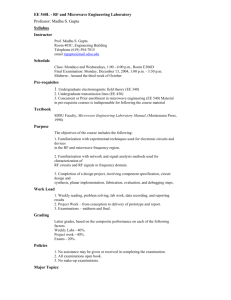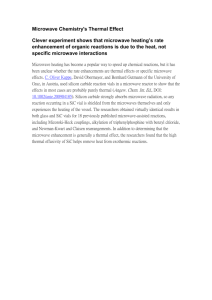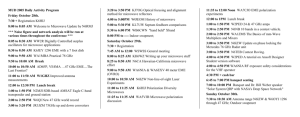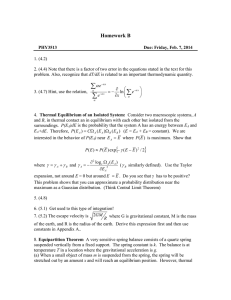XI. MICROWAVE AND MILLIMETER WAVE TECHNIQUES
advertisement
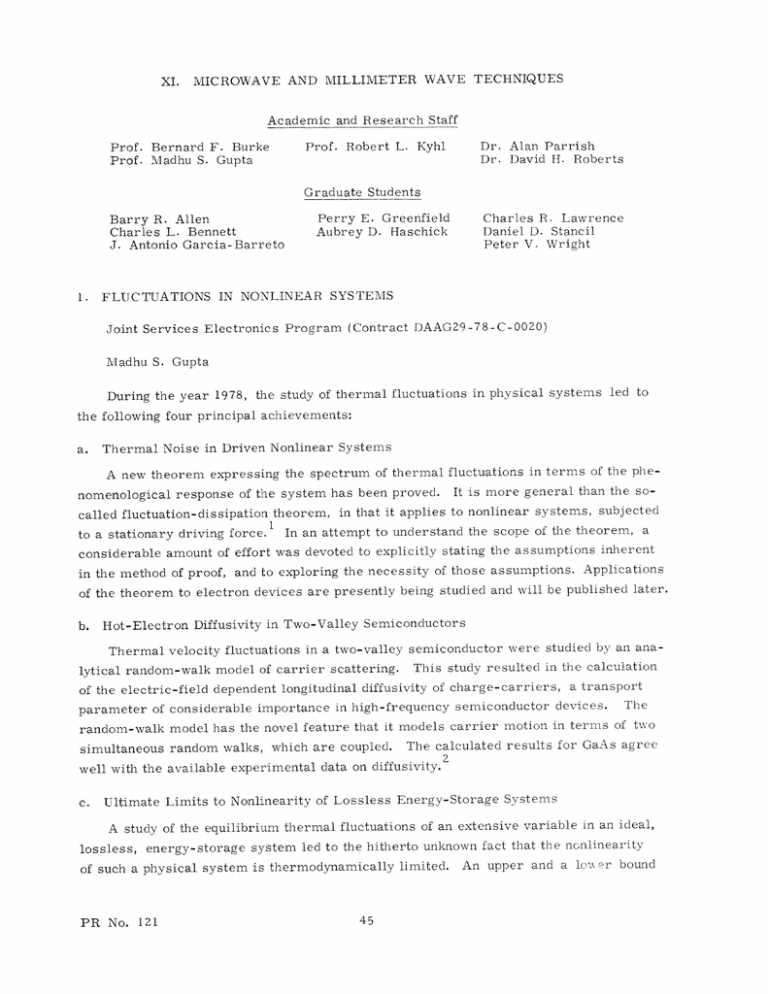
XI. MICROWAVE AND MILLIMETER WAVE TECHNIQUES Academic and Research Staff Prof. Bernard F. Burke Prof. Madhu S. Gupta Prof. Robert L. Kyhl Dr. Alan Parrish Dr. David H. Roberts Graduate Students Barry R. Allen Charles L. Bennett J. Antonio Garcia-Barreto 1. FLUCTUATIONS Perry E. Greenfield Aubrey D. Haschick IN NONLINEAR Charles R. Lawrence Daniel D. Stancil Peter V. Wright SYSTEMS Joint Services Electronics Program (Contract DAAG29-78-C-0020) Madhu S. Gupta During the year 1978, the study of thermal fluctuations in physical systems led to the following four principal achievements: a. Thermal Noise in Driven Nonlinear Systems A new theorem expressing the spectrum of thermal fluctuations in terms of the phenomenological response of the system has been proved. It is more general than the socalled fluctuation-dissipation theorem, in that it applies to nonlinear systems, subjected to a stationary driving force.l In an attempt to understand the scope of the theorem, a considerable amount of effort was devoted to explicitly stating the assumptions inherent in the method of proof, and to exploring the necessity of those assumptions. Applications of the theorem to electron devices are presently being studied and will be published later. b. Hot-Electron Diffusivity in Two-Valley Semiconductors Thermal velocity fluctuations in a two-valley semiconductor were studied by an analytical random-walk model of carrier scattering. This study resulted in the calculation of the electric-field dependent longitudinal diffusivity of charge-carriers, a transport The parameter of considerable importance in high-frequency semiconductor devices. random-walk model has the novel feature that it models carrier motion in terms of two simultaneous random walks, which are coupled. The calculated results for GaAs agree 2 well with the available experimental data on diffusivity. c. Ultimate Limits to Nonlinearity of Lossless Energy-Storage Systems A study of the equilibrium thermal fluctuations of an extensive variable in an ideal, lossless, energy-storage system led to the hitherto unknown fact that the nonlinearity of such a physical system is thermodynamically limited. An upper and a lower bound PR No. 121 (XI. MICROWAVE AND MILLIMETER WAVE TECHNIQUES) were established for a measure of nonlinearity of the system. trated through the example of varactor nonlinear capacitors. The bounds were illusSuch bounds are of theo- retical interest in studies of the fundamental limitations of physical devices. d. 3 Fluctuations and Dissipation in Information Processing A one-bit information storage system is modeled as a bistable equilibrium thermo- dynamic system, with one nonthermal, conserved extensive parameter serving as the information-bearing degree of freedom. The system is assumed to be in contact with a thermal reservoir which serves to induce randomizing fluctuations within a state but does not cause jumps between the two stable states. essarily nonlinear, energy-storing, Such a system is shown to be nec- and dissipative during switching. 4 Energy dissipation during a state change of the system, caused by a flow of the extensive variable, is calculated by adding the components due to the irreversibility of flow and due to the necessity of determining the state of the system prior to state change. dissipation required is approximately 2 kT per switching operation The minimum and occurs when approximately 2 bits of information is obtained about the state of the system. It is em- phasized that this dissipation is not confined to the information storage system itself, and therefore the heat to be removed from the system may be lower. e. Microwave Devices Two other papers, describing the work of the previous year, were prepared for publication during this year. 5, 6 References i. M. S. Gupta, "Thermal Fluctuations in Driven Nonlinear Systems, " Phys. Rev. A 18, 2725-2731 (1978). 2. M. S. Gupta, "Random Walk Calculation of Diffusion Coefficient of Hot Electrons in Two-Valley Semiconductors," J. Appl. Phys. 49, 2837-2844 (1978). 3. M. S. Gupta, Systems," J. 4. M. S. Gupta, "Thermodynamics of Information Processing: pation Requirements, " to be published. 5. M. S. Gupta, "Stability Measure for Negative-Resistance Amplifiers, " Int. J. tronics 45, 241-245 (1978). 6. G. K. Montress and M. S. Gupta, "Microwave Characteristics of Silicon BARITT Diodes under Large-Signal Conditions, " to appear in IEEE Transactions on Microwave Theory and Techniques, Vol. MTT-27, No. 5, May 1979. PR No. 121 "Thermodynamic Limits to Nonlinearity: Appl. Phys. 50, 569-573 (1979). Lossless Energy Storage Minimum Energy DissiElec- (XI. 2. MICROWAVE AND MILLIMETER WAVE TECHNIQUES) THE M.I. T. THREE-ELEMENT MICROWAVE INTERFEROMETER National Science Foundation (Grant AST77-26896) Bernard F. Burke, Barry R. Allen, J. Antonio Garcia-Barreto, Perry E. Greenfield, Charles L. Bennett, Charles R. Lawrence The M. I. T. aperture-synthesis microwave interferometer consists of two fixed and one movable 5.5-meter paraboloids suitable for wavelengths as short as 7 mm. The antenna separations are east-west, and range between 9 and 300 meters. At the current operating frequency of 22 GHz, these correspond to spacings between 680 and 23, 000 wavelengths. The 22-GHz radiometers are conventional regulated ambient-temperature diode mixers fed by circular polarizers. The bandwidth is 75 MIHz, and the double-sideband noise temperature is approximately 600 K. The IFs are sampled at 150 MHz by ECL comparators, and are correlated and summed in eight parallel streams at 18.75 MHz in a three-level scheme. Digital delays between 6.7 and 853. 3 ns in 6.7-ns steps are accomplished by multiplexers and latches at 150 MHz and by shift registers clocked at 18.75 MHz. Additional cable delays of 0.83, 1.67, and 3. 33 ns are used to keep the system response within 1 percent of optimal. A Nova 820 minicomputer controls the pointing of the antennas, steps the delays, interrogates the correlators, performs a real-time fit to the fringes, and writes the results on magnetic tape. The interferometer has recently been brought into operating condition, and we are beginning to take data toward aperture synthesis. Panel adjustments in two of the dishes have resulted in substantial increases in antenna efficiency, which we now measure to be approximately 0. 50. The antenna pointing scheme has been revised. Corrections for azimuth zero-point, gear-ratio, and collimation error and for zenith gear-ratio and collimation error are now made by real-time computer evaluation of empirically determined correction formulae. This replaces a table lookup procedure which resulted in unacceptably large pointing discontinuities at some positions in the sky. Further im- provements in the operating system which are under way include extension of its unmanned operating capability to permit an arbitrarily long sequence of sources to be observed automatically. The processing of visibility data from the interferometer will be accomplished by a combination of M. I. T. and NRAO programs on the M. I. T. IBM/370 computer. The M. I. T. software performs minor corrections related to the real-time fringe fitting. The NRAO-VLA package (kindly provided by Dr. Eric Greisen) has been modified for our site, antenna configuration, and computer. This package of programs is especially well suited to our system since, like the VLA, we have alt-az mounted dishes and employ circular polarizers. ging is beginning. PR No. 121 Adaptation of these programs is being completed, and debug- Preliminary working versions of the M. I. T. programs exist in MICROWAVE AND MILLIMETER (XI. WAVE TECHNIQUES) Fortran, but these will be translated into PL/I for compatibility with the VLA package. This development has value for other programs as well, since we are making extensive VLA studies, and will be doing much of the processing in-home eventually. Our first goal is to produce a high-quality map of the supernova remnant One year ago, peia A. tem were uncovered, a number of subtle flaws in the sys- as we began this project, and we are confident that they are now all fixed. During the summer a study of Saturn and its rings was made, of 1978, Cassio- and we derived an upper limit of 250 for the apparent brightness temperature of the map. was clearly a problem in these measurements, more interesting measurement. Amplitude stability of the system which would otherwise have produced a During the fall and winter of 1978 the problems were We built circularly polarized feeds for grappled with, and the system is ready to go. the system, which makes the separation of total-power distribution and linear-polarization distribution far more tractable for strongly polarized sources such as Cas A. Calibration data are currently being taken with the system. the system has always been good (30 repeatability day-to-day), Cas A should proceed during the summer and fall of 1979. be derived, followed by a polarization map. The phase stability of and the synthesis of A total-power map will first The resolution of the maps will be com- parable to that of the best studies made at longer wavelengths. By studying the degree of polarization at the shorter wavelength, compared to the more depolarized and Faradayrotated longer wavelength studies, we should be able to make a detailed study of magnetic-field strength and geometry in the remnant. region DR21, We also plan to map the compact H II which requires relatively few interferometer spacings for a complete map. The next step in the interferometer work will be to change the frequency to 43 GHz. While we could continue working at 22 GHz, we have developed a high-quality cooled mixer for 43 GHz that is described in our new NSF research proposal. interferometry is a largely unexplored field, Millimeter-wave and while some interesting work will re- main at 22 GHz, many of the more attractive possibilities will be better studied by the VLA. (Cas A is not a practical VLA target, and is much better suited to our small system.) In view of our greatly improved system noise temperature at 43 GHz, a change in observing frequency at the close of the Cas A synthesis work is indicated. At the same time, we are developing a 100-channel crosscorrelator that should also be ready for use in early 1980. Studies of SiO radiation will be made with the system, but continuum and other line sources will also be studied. There is a philosophical point that should be made concerning the interferometer. If we chose to make it the major focus of our observing program, concentrating our five graduate students, three engineers, and one or two postdoctoral graduates on the proj- ect, it would proceed at a far more rapid pace. however, PR No. It would not then be a small project, and the major thrust of our graduate student training and research 121 program (XI. would be drastically changed. MICROWAVE AND MILLIMETER WAVE TECHNIQUES) As it now stands, the interferometer project represents an incremental cost to the program of about $70,000 per year, force is also used for other developmental programs, and observing hardware for VLBI experiments. since the engineering such as building new front ends Most of the hardware in recent years has come from M. I. T. private funds, and the result has been to provide a unique training ground for students. Our graduate students have always been in high demand, they are familiar with hardware and software, national facilities. since and are experienced in the use of major The interferometer gives a truly effective introduction to the real world of instruments, without which there would be no observing. existence both as a teaching tool and as a driver for new research. It thus justifies its We have developed the fastest correlator presently in use in radio astronomy, and future state-of-the-art developments will continue. PR No. 121
